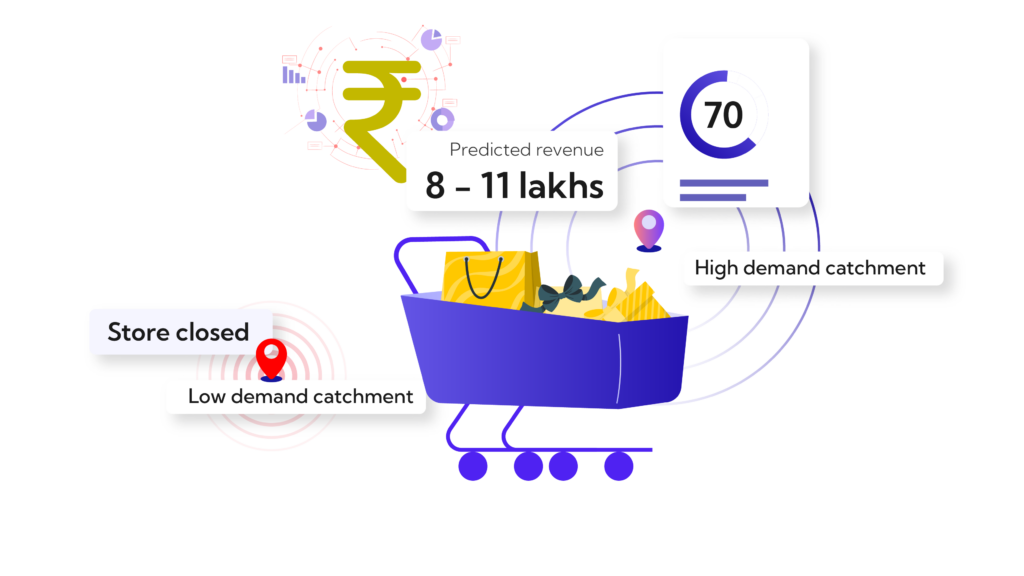Retail is a high-stakes industry. Every square foot of store space is a calculated risk. And established retailers are feeling the pinch.
This pinch of volatility is due to evolving consumer behaviour, and dynamic economic fluctuations. Many stores are shutting down. Even Reliance shut 24 Centro stores this year.
Meanwhile, new-age, tech-enabled businesses are finding ways to thrive. Leveraging data, tech, and AI, they are finding profitable stores faster.
Embracing data-backed decisions for a resilient retail model
Retailers in India and globally have witnessed firsthand the repercussions of not anticipating market trends.
A recent report showed that more than 9,000 retail stores in India were shuttered in 2020 alone. Large players, too, were not immune: Shoppers Stop and Future Group faced substantial downsizing as foot traffic plummeted and costs escalated.
When a store closes, the losses are far-reaching—impacting real estate investments, customer trust, inventory, and brand reputation. For instance, a single high-street store closure in a prime location like Delhi’s Connaught Place can result in inventory losses and contractual lease obligations that amount to millions.
With access to comprehensive location intelligence and predictive analytics, however, retailers can begin to reverse this trend. To identify the ideal location for a store and ensure that the store doesn’t shut down the line, businesses need to understand:
- Where their customers live and shop
- What is the total addressable market within a city
- How big is their trade area
- Where are shoppers coming from
- What is the ideal product mix to serve your customers at a specific store
- What are the footfall patterns, and much more
Understanding these and more location factors allows for informed decisions on where to open, retain, or close stores. The future of retail lies in these insights, which guide everything from site selection to product mix, ultimately reducing risk and ensuring stores remain viable long-term.
The Hidden cost of store closures: an example of hard lessons learned
A single-store closure is more than just lost sales; it’s an operational setback with ripple effects across the entire brand. During the pandemic, many Indian brands found themselves downsizing. Future Retail, for instance, closed dozens of stores, incurring heavy losses due to inventory write-offs, lost customer touchpoints, and reduced brand visibility.
Each shuttered store represents a trust gap with consumers who question the brand’s stability. For retailers in India, where brand loyalty is hard-won, such closures can have a lingering impact on customer retention.
Furthermore, real estate costs are non-trivial. A retail store in Mumbai or Delhi can come with a lease upwards of ₹3-5 crore annually, a sum that can become a liability if a location underperforms or closes prematurely. For instance, a mid-size brand shutting down a store with a five-year lease left could end up paying penalties that wipe out profit margins from multiple stores.
To delve deeper into this accumulated cost factor, click to read more.
Future-proofing with data and AI
Future-proofing retail isn’t just about reducing closures; it’s about maximizing every store’s potential and ensuring consistent growth. With location data analytics, we have the tools to make decisions that sustain growth even in a challenging market. Here’s how these insights empower retailers:
- Identifying Ideal Store Locations: Location data provides insights into foot traffic patterns, local demographics, catchment characteristics, trade area, total addressable market, competitor presence, and more; enabling retailers to choose sites with the highest potential for success.
- Revenue Prediction: Predictive analytics offers a clearer picture of potential revenue in any new location, helping prioritize high-yield sites. For any prospective location, retailers can forecast revenue estimates to predict the chances of success or failure of the store.
- Demand Mapping: By analyzing consumer demographics, income levels, spending patterns, etc., retailers can identify areas with high demand for specific products or services, ensuring that stores are stocked with the right inventory.
- Risk Assessment: Location data helps retailers identify potential risks such as market saturation, risk of cannibalization, and the ultimate risk of store closure.
- Growth Trends and Market Insights: Data-backed growth trend analysis lets retailers understand how a location’s market might evolve in the future. In cities with rapid growth like Pune, understanding projected shifts in infrastructure and residential areas can enable strategic store placements, ensuring they remain relevant as neighborhoods expand.
Turning data into strategy
Imagine planning an expansion strategy where every store location, product mix, and promotional campaign aligns precisely with customer behavior, footfall, and local demand.
This approach is no longer aspirational; it’s achievable through the smart application of data. A successful future in retail demands that we leverage these tools to make informed decisions that benefit our brands, customers, and stakeholders.
As a leader in retail, the value of data is undeniable. These insights do more than mitigate risk—they drive strategic growth, ensuring each store contributes meaningfully to the bottom line. By embracing location intelligence and predictive analytics, we gain the flexibility and foresight to ensure resilience in dynamicity.
Conclusion: building for the long haul
In today’s retail landscape, resilience and adaptability are key to sustainable growth. Our mission is to equip retailers with the tools and insights needed to navigate this dynamic market. With our data-driven solutions, retailers can make strategic, location-based decisions ensuring that each store becomes an asset rather than a risk.
By harnessing the power of location intelligence, retailers are better positioned to drive profitability, retain brand loyalty, and remain agile in the face of challenges. As the industry evolves, we stand committed to empowering retail brands to future-proof their growth strategies with actionable, data-backed insights.



